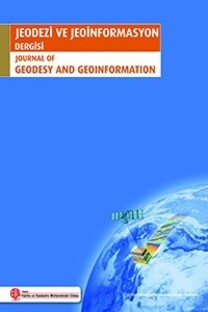Terkos Havzası Sulak Alanları ve Civarının Hyperion EO-1 Görüntüsü ile Sınıflandırılması
Uzaktan algılama, Görüntü İşleme, Sınıflandırma, Hyperion EO-1, Sulak Alan.
Classification of Terkos Basin Wetlands Environment Using Hyperion-EO-1 Image
Remote Sensing, Image Processing, Classification, Hyperion EO-1, Wetlands.,
___
- Adam E, Mutanga O, Rugege D, 2010: Multispectral and hyperspectral remote sensing for identification and mapping of wetland vegetation: a review, Wetlands Ecology and Management, 18, 3, 281-296.
- Adler Golden M. S, Matthew M. W, Bernstein, L. S, Levine, R. Y, Berk A, Richtsmeier S. C, Acharya P. K, Anderson G. P, Felde G, Gardner J, Hoke M, Jeong L. S, Pukall B, Mello A, Ratkowski A, Burke H. H, 1999: Atmospheric correction for shortwave spectral imagery based on MODTRAN4, SPIE Proceeding, Imaging Spectrometry V, 3753.
- Bektaş Balçık F., 2010: Mapping and Monitoring Wetland Environment by Analysis of Different Satellite Images and Field Spectroscopy, Doktora Tezi, İTU Fen Bilimleri Enstitüsü, İstanbul.
- Butera M. K, 1983: Remote Sensing of Wetlands. IEEE Transactions on Geoscience and Remote Sensing, 21, 3, 383–392.
- Cudahy T. J, Hewson R.D, Huntington J.F, Quigley,M.A, ve Barry P.S, 2001: The performance of the satellite-borne Hyperion Hyperspectral VNIR-SWIR imaging system for mineral mapping at Mount Fitton, South Australia, Proceedings, IEEE 2001 International Conference on Geoscience and Remote Sensing.
- Dechka J.A, Franklin S.E, Watmough M.D, Bennett R. P, Instrup, D.W, 2002: Classification Of Wetland Habitat and Vegetation Communities Using Multi-Temporal Ikonos Imagery In Southern Sakatchewan, Canadian Journal of Remote Sensing, 28, 5, 679-685.
- Eastman, R.J, 2001: Guide to GIS and Image Processing Volume.2, Clarke Lab. Clark University Worcester, MA USA, 57-74.
- Galvão L. S, Formaggio A. R, ve Tisot D. A, 2005: Discrimination of sugarcane varieties in Southeastern Brazil with EO-1 Hyperion data, Remote Sensing of Environment, 94, 4, 523- 534.
- Goodenough D.G, Dyk A, Niemann K.O, Pealman J.S, Chen H, Han, T, Murdoch M, ve West C, 2003: Preprocessing Hyperion and ALI for forest classification, IEEE Transaction on Geoscience and Remote Sensing, 41, 6, 1321−1331.
- Guerschman J. P, Hill M. J, Renzullo L. J, Barrett D. J, Marks A. S, ve Botha E. J, 2009: Estimating fractional cover of photosynthetic vegetation, non-photosynthetic vegetation and bare soil in the Australian tropical savanna region upscaling the EO-1 Hyperion and MODIS sensors, Remote Sensing of Environment, 113, 5, 928-945.
- Jackson B. B, 1983: Multivariate Data Analysis: An Introduction, Irwin, Homewood, Illinois, USA.
- Jensen J.R, Hodgson M.E, Christensen E. Mackey, H. E, Tinney L.R., ve Sharitz R, 1986: Remote sensing of Inland Wetlands: A Multispectral Approach, Photogrammetric Engineering and Remote Sensing, 52, 1, 87-100
- Kindscher K, Fraser A, Jakubauskas M.E, ve Debinski D, 1998: Identifying Wetland Meadows in Grand Teton National Park Using Remote Sensing and Average Wetland Values, Wetlands Ecology and Management, 5, 265-273.
- Kokaly R. F, Clark R. N, 1999: Spectroscopic determination of leaf biochemistry using band-depth analysis of absorption features and stepwise linear regression, Remote Sensing of Environment, 67, 267–287.
- Mitsch W. J, ve Gosselink J. G, 2000: Wetlands, 3rd edition, John Wiley & Sons, Inc., New York.
- Mumby P. J, ve Edwards A. J, 2002: Mapping Marine Environments With Ikonos Imagery: Enhanced Spatial Resolution Can Deliver Greater Thematic Accuracy, Remote sensing of Environment, 22, 12, 2377-2400.
- Özeşmi S. L, ve Bauer M. E, 2002: Satellite Remote Sensing Of Wetlands, Wetlands Ecology and Management, 10, 381-402.
- Özhatay N, Byfield. A, ve Atay, S, 2003: Türkiye’nin Önemli Bitki Alanları, WWF Turkiye, MAS Press (in Turkish).
- Ramsar Convention Bureau, 2002: The Ramsar Convention on Wetlands, http://www.ramsar.org, 01.08.2010
- Rundquist D. C, Narumalani S, Narayanan, R, M, 2001: A Review of Wetlands Remote Sensing and Defining New Considerations, Remote Sensing Reviews, International Journal of Remote Sensing, 20, 3, 207-226
- Schmidt K. S, Skidmore A. K, 2003: Spectral discrimination of vegetation types in a coastal wetland, Remote Sensing of Environment, 85, 1, 92-108.
- Yılmaz R, 2010: Monitoring land use/land cover changes using CORINE land cover data: a case study of Silivri coastal zone in Metropolitan Istanbul, Environmental Monitoring and Assessment, 165, 1-4, 603-615
- ISSN: 2147-1339
- Yayın Aralığı: Yılda 2 Sayı
- Başlangıç: 2012
- Yayıncı: TMMOB Harita ve Kadastro Mühendisleri Odası
Portal Teknolojisi ve Ulusal Konumsal Veri Altyapısı
Muhammet Emre YILDIRIM, Çetin CÖMERT, Portal TEKNOLOJİSİ
Türkiye Ulusal Ortofoto Bilgi Sistemi ve Gerçekleştirilen Çalışmalar
Hadi Hakan MARAŞ, Özlem AŞIK, Altan YILMAZ, Akın KISA
Terkos Havzası Sulak Alanları ve Civarının Hyperion EO-1 Görüntüsü ile Sınıflandırılması
Filiz Bektaş BALÇIK, Çiğdem GÖKSEL
TUSAGA-AKTİF CORS-TR Sisteminin Tapu ve Kadastro Genel Müdürlüğüne Katkıları
Ömer YILDIRIM, Çetin MEKİK, Sedat BAKICI
Hassas Nokta Konumlama Tekniğinin Hidrografik Ölçmelerde Kullanılabilirliği
Reha Metin ALKAN, Yunus KALKAN
GNSS Antenlerinin Faz Merkezi ve Değişiminin Araştırılması
Engin GÜLAL, N Onur AYKUT, Burak AKPINAR, S Özgür UYGUR
Dursun Zafer ŞEKER, Necla ULUĞTEKİN, Çiğdem GÖKSEL, Hande DEMİREL, Ahmet Özgür DOĞRU, Ufuk ÖZERMAN, Cengizhan İPBÜKER, Ergin TARI
Çoklu Frekanslı GNSS Ölçüleri İle Anlık Bağıl Konum Belirlemede Stokastik Model Oluşturma
Dünyada Üç Boyutlu Kadastro Uygulamaları
Fatih DÖNER, Cemal BIYIK, Osman DEMİR
Tuzla Fayı ve Civarında Yerkabuğu Hareketlerinin Jeodezik Yöntemler ile İncelenmesi
Haluk ÖZENER, Aslı DOĞRU, Esen ARPAT, Mustafa ACAR, Bülent TURGUT, Onur YILMAZ, Kerem HALICIOĞLU, Aslı SABUNCU, Emre HAVAZLI
